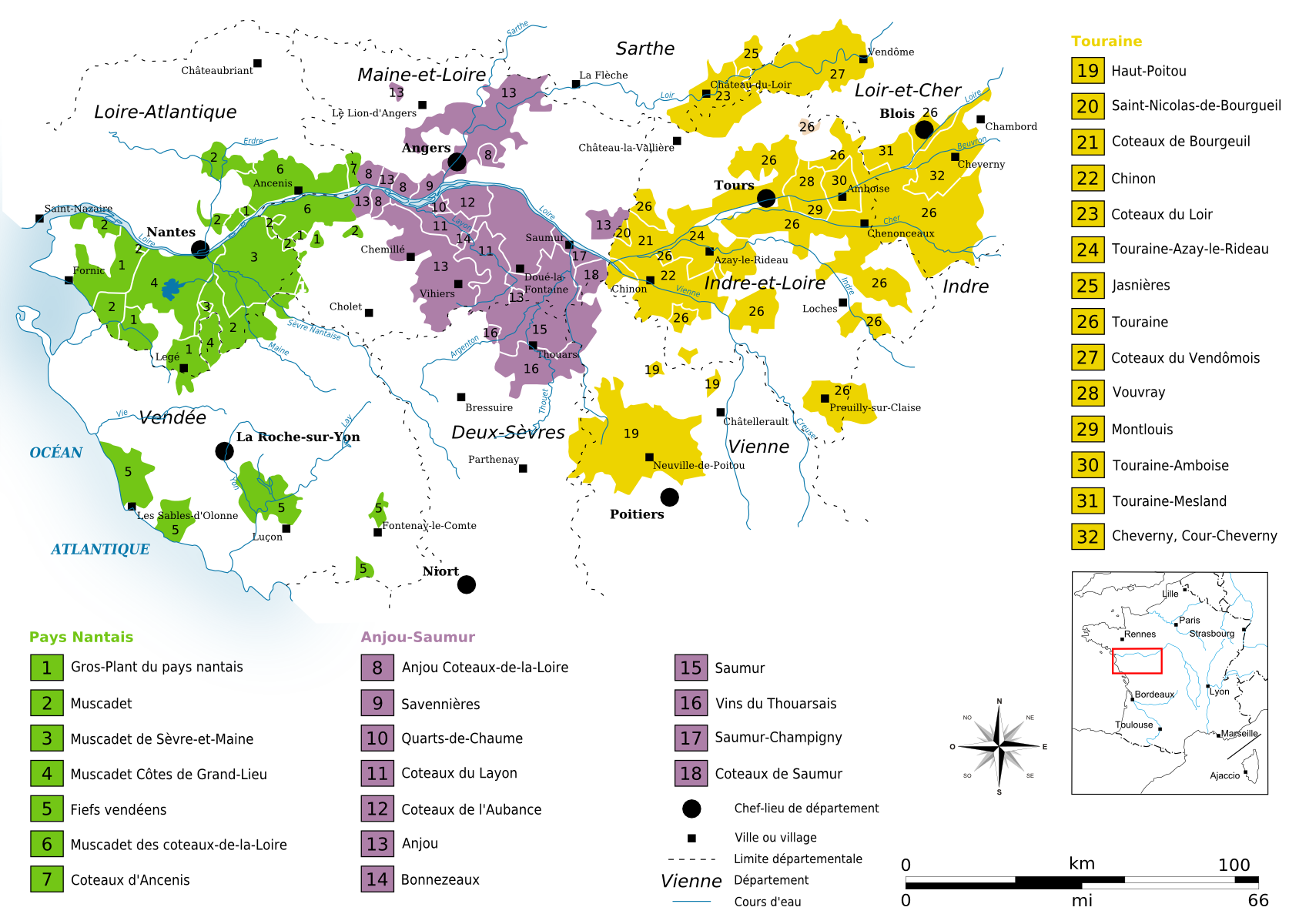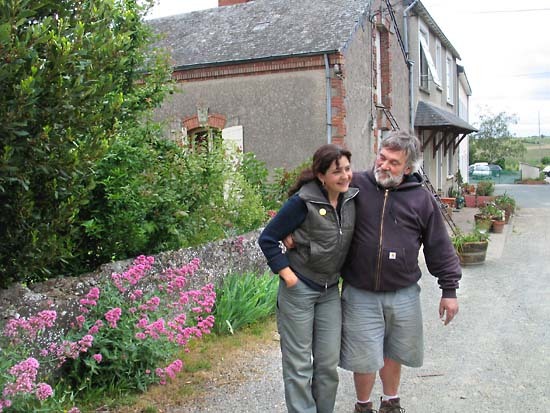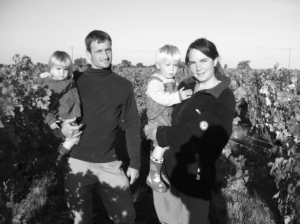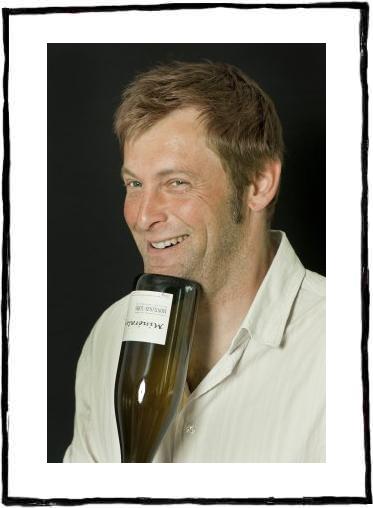“I’d give my goddam soul for a glass of Vouvray.”
–Jack Torrance

This supremely versatile and noble Loire grape makes all styles from petillant and sparkling to bleach-bone dry, tender, moelleux and sensationally sweet. Extremely popular in South Africa where it used to be known as Steen but has now acquired new credibility owing to the efforts of a handful of growers who respect the potential of the grape variety, it is also found in small pockets of Gisborne in New Zealand (the versions made by James Millton are superb), California, Australia and Argentina, and in France in the VDQS of Entraygues et Le fel and Estaing.
We love Chenin that is harmonious product of good farming and natural winemaking. Variety is the spice of this these wines. Some are taffeta, others have jolting, sour acidity, some are rough-skinned, others show a delicate floral side – think clover, acacia, appleblossom – some reveal bitter almond notes, and fruit may range from fleshy quince, wild apple and honeydew melon towards more restrained citric styles. Same grape, similar – but not identical – methods of farming and vinification, yet different and highly valid styles emerge – according to terroir and vintage. Tasting the wines next to each other demonstrates the fallacy that asserts that all natural wines are homogenous; these wines are evidently the result of the highly individual circumstances that exist in each vineyard, the equally individual set of circumstances that obtain in each winery, the peculiarity of wild ferments, the timing and degree of sulphur additions and the manifold marginal decisions of the vignerons. Those people who can’t taste the obvious differences adhere to the strange dogma that (rather than nature and the man/woman) that the natural philosophy somehow maketh the wine. Winemaking is a journey of many detours. Natural winemaking is the detour.
Traditionally, Chenin was always vinified in old barrels and made oxidatively. Unlike other regions where this style of winemaking is viewed as unclean and even faulty, the small artisan growers of the Loire cleave to the view that the grape should develop aromatically in the mouth and present an arc of flavours from apple through nuts to honey. Chenin may be all textures and angles; unlike Riesling with its floaty-ethereal thang, Chenin revels being all over the palatal shop – with smells and tastes that encompass stones and earth, sweet and sour fruit, fulminating acidity, honey and spice, nuts and truffles.
The Homeland – Chenin in the Loire

We begin our Chenin journey on the Atlantic coast within Thierry Michon’s biodynamic island domaine in the reclaimed marshes of the Fief-Vendée. Our grapes appears in two cuvées, namely Les Clous, a blend of Chenin, Chardonnay and Grolleau Gris from clay schist soils and Les Haut des Clous, pure Chenin. The former is beautifully distinctive with aromas of the forest and the sea; the wine has flavours of candied fruit with a wet rock element. It finishes dry with the cool-climate hallmark of refreshing linear acidity. Le Haut des Clous pumps up the volume with floral, persimmon, green almond, apple-and-pear notes stretched over a bright, elegant frame. You can almost smell the marsh in the aromas present, manifesting as heather, lavender and almond.
Savvy Cheninistas will tremble appreciatively at the mention of Savennières (a small area south-west of Angers) where Chenin is known as Pineau de la Loire. Here the grape produces wines of immense concentration and longevity. Depending on the composition of the soil and the vintage the wines from Savennières can be nervous, with high acidity and a dry almondy aftertaste; other examples verge on the tendre with ripe flavours of honeydew and quince. The sandy schist soils and the lieu-dit of Roche-aux-Moines occupies a mere 6.85 hectares within the Savennières AOC. One of these domaines is the appropriately-named Domaine aux Moines owned by Mme Laroche. Vineyard practices here are designed to protect the environment, yields are low, organic fertilisers are used. Thermoregulated stainless steel vats and a pneumatic press ensure that pure fruit quality and gentle extraction are the order of the day. There is also a “petit chai” with twenty-five oak barrels in which the best selections of each vintage are either fermented or aged, although the object is not to acquire a woody flavour in the wine. In exceptional vintages a doux or slightly sweet wine is produced. One can vertical – and horizontal – with their old vintages. Whereas younger versions have verve, nerve and coiled tension, ten years down the line we may find powerhouses with still diamond-bright acidity and a beeswaxy texture, where the evident ripeness of the fruit is balanced by the muscular minerality of the wine, truly an unfiltered philtre. Try these wines with grilled wild salmon, andouillette, rabbit in white wine or veal chop à la crème.
There’s old and there’s older. And the older the golder. Old Savvy mellows (dis)gracefully. Some shaggy specimens will exhibit rich aromas of apple bakewell, papaya, toasted oatmeal and honey, sherry and old musk, secondary development veering towards roast mushroom. Typical Chenin that, as it ages, the honey notes become drier and it acquires a bruised fruit mingled with soft nutty character. Some vignerons use chestnut to age their wines, the casks seeming to imbue the wine with that sweet flavour.
Sylvain Martinez, a young vigneron passionate about working the vines in harmony with nature, has followed in the steps of his grandfather, a peasant farmer who instilled in him a respect for the soil. After ten years’ experience with Mark Angeli and René Mosse he then worked alongside Olivier Cousin where he learned la traction animale. His vines, average age 80 years, on schist soils over a bedrock of volcanic sandstone, are from a small parcel situated in the heart of Coteaux du Layon. This is dirt-under-the-fingernails artisan viticulture. Ploughing is by horse, no chemicals are used and only natural, organic solutions are sought. Yields are a minuscule 10 hectolitres/ha and a manual harvest with strict selection is carried out in small cagettes. Vinification is very slow with light pressure using an ancestral press. Fermentation and maturation is in old barrels for fourteen months before the wine is bottled on the lees without filtration or added sulphur. Goutte d’O (drop of water), a beautiful wine rippling with tension, possessing an exceptional, precise minerality, unveils subtle aromas of poire, mirabelle and shaved quince, dried fruits and herbs. The vintage variations in the Loire are extraordinary – to describe a wine in one year is never to nail the style. The 2007, for example, is lean, tart and medium-bodied, whereas the 2008 is burnished gold, viscous, honeyed with hints of botrytis and a wallop of alcohol.

Agnès & René Mosse adopted organic viticulture techniques from the start, ploughing between and under the rows, and used biodynamic preparations to treat the vines and soil. In their area of Anjou Noir (Black Anjou, so called because of the dark colour of the soils of slate and volcanic rocks), the soils are shallow, with subsoils of schist and sandstone, and varying amounts of clay on the surface.
With all the efforts put into vineyard work, it was equally important to them to vinify in a natural fashion, and they are particularly attentive to minimizing manipulations and the use of sulphur. All the wines are barrel-fermented and aged, and usually the whites go through their malolactic fermentation. The barrels are renewed as needed: they are containers, not oak flavour providers.
The Anjou Blanc sec is from young selection massale Chenin vines planted in 2001 & 2002 grown on clay and gravel soils alternating with schist. Yields are sometimes less than 15hl/ha and harvest is done by hand with selection (tri) of grapes. Vinification is slow, malo takes place in barrels and the wine spends a further year in them before bottling. Wild honey, fleshy apricots, quince paste and woodspice. Once the wine warms up in the glass it develops secondary nutty aromatics and layer after layer of rich flavour.
The Bonnes Blanches (BB) is a 2.5ha parcel of thirty-five year old vines on a special terroir of sandstone with a subsoil of decomposed schists. Ample, mineral, long in the mouth this wine has profound texture. Honeydew melon and sweet quince, candied apple, vanilla and gorgeous pineapple acidity all the way to the bottom of the glass, the back of the palate and from the top of the tongue to the tips of your toes.
Benoit Courault is a young grower in Faye d’Anjou, another who declassifies his production into Vin de France. The Gilbourg (name of one of his plots) is pure, but not so simple, Chenin. Sixty year old vines, very low yields, long vinification, wild yeast ferment without temperature control and maturation for twelve months in three to five year old barrels, makes for a rich, earthy style of wine with bruised orchard fruit. Imagine ripe apples rolled in honey-coated green leaves then add cinnamon and musk and some spiky acidity for definition. The wine moves, sometimes more mellow and textured, sometimes sharper and delineated. His baby wine – Le Petit Chemin – crackles with electric freshness and a Pet Nat of the same name does it with bubbles.
Stéphane Bernaudeau trained in the Loire region to be a ‘bûcheron’ (lumberjack/ logger/woodman.). It was not ok so he ended up working for the great Mark Angeli (where have we heard this name?) in the village of Thouarcé, where he still helps out to this day. In 1999 he started working for himself, farming a few acres before acquiring a patchwork of parcels, partly rented and partly purchased. Currently he has a total of 2.5 hectares of vines consisting of three parcels of Chenin, one of which is located at Aubigné-sur-Layon, another at Thouarcé and the last one in the village of Cornu. Terres Blanches is from 80-year-old low-yielding Chenin vines. Grapes are first pressed then fermented in (used) oak barrels for twelve months. Stéphane allows a partial malolactic intentionally in order to conserve the wine’s acidity. The wine is then aged for twelve months in used oak barrels, is neither filtered, nor fined and given a small amount of sulphur.
So where does this sit in our Chenin pantheon? Roasted almonds leading into beeswax, some sweet apples and quinces opening out to reveal some beautiful aromas and flavours of fresh cut pineapple and honey. Sumptuous and rich with a suggestion of waxed apples, herbs and cheese, a touch of wood tannin grip. A profound wine, this would age for fifteen to twenty years.
Les Nourrissons is a 100-year-old one hectare plot of Chenin Blanc and Verdelho, biodynamically farmed, producing on average 1,000 bottles a year. Stéphane ploughs with a horse, picks ripe, makes a natural ferment and ages for fourteen months on the lees in barrels used for three wines. This is a wine of power, tension, acidity and fantastic length.
La Coulée d’Ambrosia is a 4 ha estate on limestone-clay soils with schists and silex in Beaulieu-sur-Layon, practising and certified for organic viticulture since 2005. Now Jean-François Chene is well on the road to biodynamics. He specialises in Chenin in all shapes and sizes and loves to make a “Jura-style” wine under a yeast veil. According to Jean-François Paniers des Fruits is his lovely user-friendly, basket-of-fruit-wine, a flavoursome apple compote wine for easy-drinking.
You might stare into the crud-rich opalescent depths of the wine and say Chenin Voile? More like Chenin Vile. There is a lot of something in suspension, a soot snowstorm in this murky, muzzy, membranous “white” (ironic inverted commas).
“J’ai choisi d’aller au bout de mes convictions en minimisant les interventions en cave et ainsi laisser s’exprimer le fruit et le minéral. J’obtiens alors des vins « vivants » éloignés des standards, des vins qui interpellent».”
O2 is more than a nod and a wink, (Jean François nods and winks a lot) to the wines of the Jura that he admires so greatly. He has a seraglio of Chenin that has taken the veil, ageing for approximately three years under those cheesy yeasts. The initial aroma is not altogether pleasant – butter on the turn and smoking corn on the cob mixed with oxidative notes. Carafed, the wine begins its subtle transformation, shedding noxious aromas and releasing hints of fruit – here be apples, slivers of toasted almonds and dried spice. Those sly salty Jurassic flavours come to the fore and the acidity reins in the funkiness. This is either a food accompanier, Comté, or a goat’s cheese, or a gentle sipper, something to get down and meditative with, one of those wines that evolves as you revolve it around the glass. Yes, this O2 may not be your favourite Chenin network, but it certainly connects to your inner yeast. Jardin de Chiron is named after the centaur, in Greek mythology, who discovered the use of plants for medicine. Like all his white wines this Chenin is fermented in futs de chêne with wild yeasts. The entire vinification takes twenty-four months and the wine spends a total of three years in barrels without topping up. Crazy as a soup sandwich.

Les Vignes Herbel is the relatively embryonic project of Laurent Herbel and Nadège Lelandais who started in 2005 and now have a three-hectare parcel of vines at Rochefort-sur-Loire called La Pointe on a terroir of purple schist and clay. This includes 1.4 ha of Chenin Blanc planted in 1920 and 1.6 ha of Cabernet (70% Franc and 30% Sauvignon) planted in 1974. They farm organically and biodynamically. La Pointe Chenin 1920 is a true vin de garde with a long elevage in wood. A beautiful wine that expresses the potential of the Chenin. Earthy and rich with a great balance of sweet fruit, acid and minerality. It smells like Chenin, fine spun wool, heather honey, punctilious acidity chiselled to an arrowhead designed to bring a bead of appreciative persp to your forehead. Reverie is a blend of two vintages (2006 & 2010) and is from botrytised grapes (5hl/ha) harvested at the beginning of November. This is the first time that it has been made and only because the conditions were propitious. The nectar is luscious indeed (215 grams residual sugar), but avoids being heavy due to the wonderful streak of lemony acidity that drives the fruit from beginning to end.
The wines from Anjou have a perceptible autumnal warmth that is beguiling. Most of them are rich, golden and spicy. Where the malo is inhibited the Chenin scythes across the tongue, where it occurs naturally the wine remind us of just churned farmhouse butter melting in an orchard on a warm autumn afternoon. If I had to find one word that captured the feel of Anjou Chenin it would be “russet” – that almost coarse texture allied to browning apples.
Saumur Chenin? Don’t mind if I do!
Thierry Germain’s Saumur Blanc l’Insolite skids effortless on its classy chassis. Made from 80-yr-old Chenin vines – with acidity as keen as a whippet with mustard on its nose and refined mineral fruit to boot it is a very high-toned wine, its purity testament to biodynamic viticulture and the paring back of the winemaker’s interventionist role. Antoine Collier’s Saumurs are also the product of old vines, low yields and biodynamic farming. Fermented and aged in barrique, however, they are lush, almost Burgundian wines. Warm honey aromas cascade from the glass, peaches and cinnamon cream fill the mouth rounded off by a whiff of toasted hazelnut.
In Vouvray Didier and Catherine Champalou make a fine array of styles. Their straight Vouvray is rounded and tender, suggestive of ripe quinces sheathed in threads of honey. The riper Vouvray ‘Cuvee les Fondraux’ from older vines has an enticing golden colour which draws you to an exotic bouquet of lavender, honey, sweet grape and marzipan. Their Vouvray Brut, called by them a ‘petillant naturel’ (natural sparkling) is exuberant – floral with a delightful nose of honey, hay and quince, and lively acidity supporting the rich apple fruit.
Catherine’s brilliant natural Vouvrays are in two words – de-licious. High toned white fruit notes meld with honeycomb and goats milk wrapped in a loving shroud of sweet blossom. The cloudy Pet Nat stems from a natural fermentation in bottle, no dosage or filtration. Somewhere between cider and perry with delicate honey notes, gently effervescent.
Despite Vouvray’s size and historic status it is Montlouis which is the truly dynamic appellation for Chenin. Jacky Blot, Lise & Bertrand Jousset, Ludovic Chanson, Francois Chidaine, Xavier Weisskopf and Frantz Saumon made a formidable range of wines in a variety of styles, showcasing the different terroirs from limestone-flint (fresher wines) to clay on tuffeau (multi-layered Chenin). The age of vines ranges from 30 years old to over 100.

Frantz Saumon is another non-interventionist and works without chemicals in the vineyards. The winery is an underground cellar carved into the tuffeau, the ubiquitous fossil-rich clay of the region, and all the wines are vinified in barrels (some 228l, some 400l) only with the indigenous yeasts. Clos de Chênes is a dry wine made from Chenin grapes from a 95 year old vineyard on silex and clay. The wine is unfiltered, brooding on the lees and no sulphur is added. With its spiky personality and honeyed texture this Montlouis is designed for the most regal salmon that you can lay your mitts on.
It is said that, maybe three or four times a century, the appellation of Jasnières makes the greatest Chenin on earth. I like this notion of a terroir wine, notoriously temperamental, that unabashedly fixes you with its glittering eye and declares: “I am what I am – take me, or preferably, leave me!” With Domaine Le Briseau the vagaries of vintage certainly determine the style of the wine: the difference, for example, between 2004 & 2005 is profound. Even the more sumptuous examples have an astringency that keeps your palate guessing. There’s warmth, waxiness and those almond notes typical of Chenin, some sly sherry aromatics and pulped-pear-mingled with-flint-fruit. And here’s the rub, the longer you leave it the more profound it becomes, so please carafe in order to allow the dry honey to become runny.
Les Vignes de L’Ange Vin was founded by Jean-Pierre Robinot, who used to run a wine bistro in Paris called L’Ange Vin for nearly 15 years. L’Ange Vin means angel wine but it is also a play on words with Angevin, a term that applies to the residents of the Anjou region and its capital Angers. Jean-Pierre Robinot is an ambitious winemaker who practices natural farming and winemaking. The white wines (70% of the production) are pressed very slowly and raised on the lees in oak barrels for at least 12 months. Charmes is from a 60 year old plot of Chenin that Jean-Pierre purchased in Jasnières. The 2008 vintage Chenin is ripe and round with a rich, long finish. The big, generous palate tastes like baked lemon meringue pie and nuts with a hint of sherry like spice. The finish lifts the ensemble with a lingering focused chalky quality.
With Robinot the plot of vines, the breathing barrels and the slow tick of the ferment animate the wines. Times moves slowly, the wines goes through their respective phases and the results challenge the orthodoxy that wine must be consistent.
For quintessential sweet Chenin the reference is surely the Bonnezeaux – a botrytis wine that demonstrates perfectly the potential of the grape – golden yellow, complex and bursting with aromas of quinces, ripe apricots and charentais melon, as well as acacia honey and exotic spices (saffron) on the palate. Combining freshness and richness it is a wine that is seductive and sensual, a typical Chenin nose with mineral notes and behind this a core of rich, honeyed aromas and a suggestion of lemony freshness with rosemary and herb nuances. On the palate it is fabulously rich yet balanced with superb acidity and, a hallmark of Chenin, a lovely fat, round, oily texture, with a deep mineral complexity.
More about Chenin to come. Watch this space!

